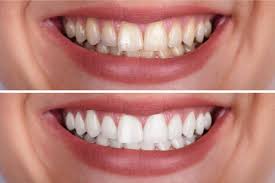A bright, white smile is a desirable asset for many, as it’s often seen as a key to confident communication. However, concerns about the safety of teeth whitening products, particularly the potential risks of swallow whitening gel, are common. Let’s delve into these issues with insights from Joy International Dental Clinic.
1. Is Teeth Whitening Harmful to Your Health?

Teeth whitening is a popular cosmetic procedure aimed at improving the color of teeth and achieving a brighter smile. Yet, many people worry about the potential health hazards associated with whitening products.
In reality, teeth whitening gels contain oxidizing agents like hydrogen peroxide or carbamide peroxide. These substances work by breaking down the molecules that cause yellowing or staining on the enamel, thus making your teeth appear whiter. When used correctly, teeth whitening products are generally safe. However, misuse or overuse, especially with low-quality products, can indeed affect your enamel, leading to increased sensitivity and discomfort. Therefore, it’s crucial to exercise caution when using any teeth whitening product.
2. What Happens if You Swallow Teeth Whitening Gel?

One of the biggest concerns when using teeth whitening products is accidental ingestion. This often occurs with at-home tray whitening, as the trays may not fit snugly for everyone, allowing the gel to leak out and be swallowed.
So, is swallowing teeth whitening gel dangerous? The answer is yes! The main components of these gels have strong oxidizing properties, which can irritate the gastric mucosa, causing abdominal pain, nausea, or even anaphylactic shock.
In sensitive individuals, swallowing whitening gel may also lead to throat burns, esophageal damage, and digestive problems. Therefore, it’s essential to be cautious during the whitening process and avoid contact of the gel with your lips, tongue, or throat.
3. What to Do if You Swallow Whitening Gel
If you accidentally swallow teeth whitening gel, don’t panic. Take the following steps to minimize the potential health risks:
- Drink plenty of water: This helps dilute the swallowed gel, reducing its irritation to the stomach and intestinal lining.

- Induce vomiting: If you feel unwell, you can try to induce vomiting to expel the gel from your stomach. When vomiting, keep your head slightly lowered to prevent aspiration into the lungs.
- Take activated charcoal: Activated charcoal can absorb toxins, helping to reduce the impact of the whitening gel on your body.
- Seek immediate medical attention if you experience severe symptoms: If you feel nauseous, have severe abdominal pain, dizziness, or difficulty breathing, seek immediate medical attention.
4. Reduce Risks by Choosing Professional Teeth Whitening at a Reputable Clinic
While at-home teeth whitening may seem convenient and cost-effective, it can lead to unwanted side effects if not done carefully. To ensure safety and optimal results, it’s best to opt for professional teeth whitening at a reputable dental clinic.
In professional clinics, the whitening procedure is performed by experienced dentists who use appropriate concentrations of whitening gel, minimizing the risk of leakage. They also utilize tools to isolate the lips and gums, preventing the gel from contacting soft tissues and causing irritation.
Additionally, modern laser whitening technology not only whitens teeth quickly but also protects the enamel and reduces sensitivity compared to traditional methods. You can have peace of mind knowing that the procedure is both effective and safe.
5. Important Tips for Using Teeth Whitening Products

To ensure safe and effective teeth whitening, keep the following essential tips in mind:
- Choose products from reputable sources: Avoid purchasing whitening products from unknown brands or unreliable sources.
- Don’t overuse whitening products: Overfrequent use can damage the enamel, making your teeth more sensitive.
- Prevent gel contact with gums: When using whitening trays, ensure they fit properly to prevent gel leakage and gum irritation.
- Follow usage instructions carefully: Each product has specific usage instructions, including the recommended duration. Leaving the gel on your teeth for too long can cause side effects.
- Replenish minerals after whitening: Use products containing fluoride to strengthen the enamel and reduce sensitivity.
- Limit consumption of dark-colored foods and beverages: After whitening, your enamel will be more sensitive, so avoid coffee, tea, soda, and other staining substances for at least 48 hours to maintain your whiter smile.
6. Debunking Common Myths About Teeth Whitening
There are many myths surrounding teeth whitening, and it’s essential to separate fact from fiction. Here are some common myths:
- Myth: Teeth whitening is a permanent solution.
- Fact: Teeth whitening results can last for several months to a few years, but they are not permanent.
- Myth: At-home whitening is just as effective as professional whitening.
- Fact: Professional whitening uses stronger concentrations of whitening agents and advanced techniques, making it more effective and long-lasting.
- Myth: Teeth whitening can damage your teeth.
- Fact: When done correctly, teeth whitening is safe and does not damage your teeth.
7. The Importance of Oral Hygiene After Teeth Whitening

Maintaining good oral hygiene is crucial after teeth whitening to ensure long-lasting results and prevent further staining. This includes:
- Brushing your teeth twice a day: Use a soft-bristled toothbrush and fluoride toothpaste.
- Flossing daily: Flossing helps remove plaque and food particles from between your teeth.
- Using mouthwash: Mouthwash can help kill bacteria and freshen your breath.
- Regular dental checkups: Visit your dentist for regular checkups and cleanings.
8. Choosing the Right Teeth Whitening Method for You
There are various teeth whitening methods available, including:
- At-home whitening kits: These kits contain whitening gels and trays that you can use at home.
- In-office whitening: This is a professional procedure performed by a dentist.
- Laser whitening: This is a type of in-office whitening that uses laser technology to enhance the whitening process.
The best method for you will depend on your individual needs and preferences. Consult with your dentist to determine which method is right for you.
Conclusion
It can be said that teeth whitening at home is an effective method. It helps you save time and money. However, if you cannot buy genuine medicine and do not know how to use the medicine. Sometimes you may encounter unexpected situations such as swallowing teeth whitening medicine. To ensure safety, you can contact Joy International Dental Clinic for detailed advice on teeth whitening methods.






